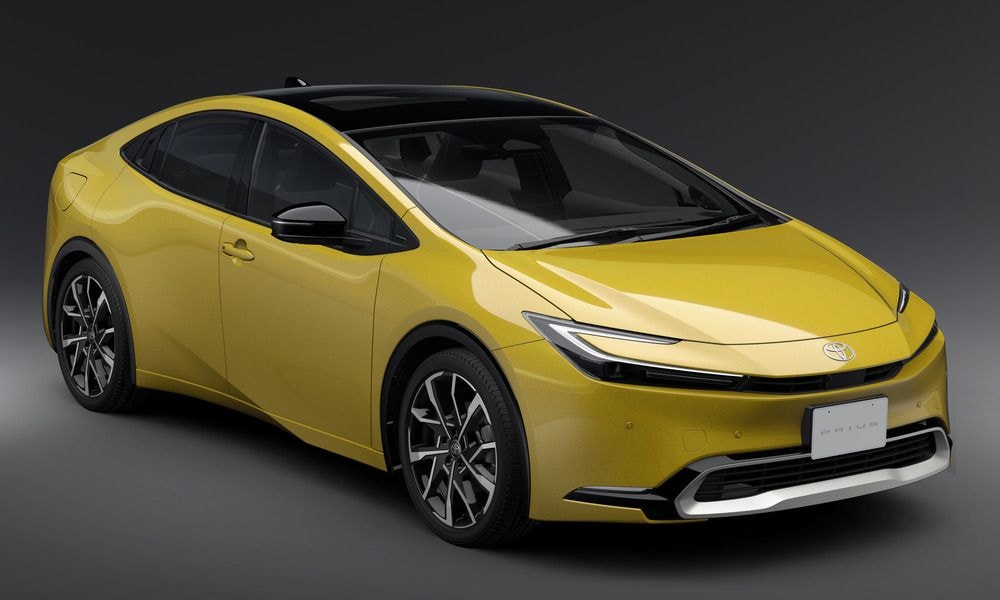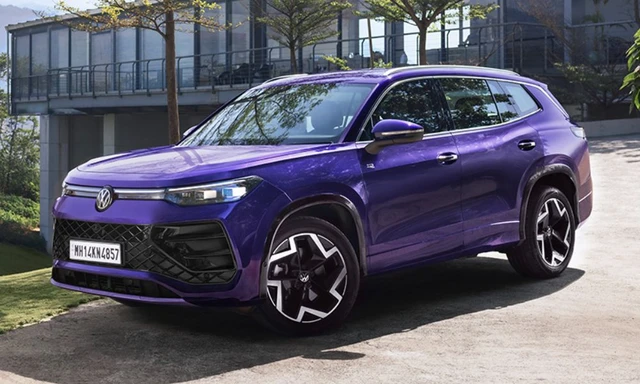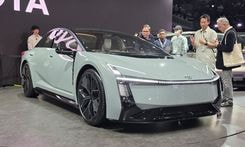Fifth-Gen Toyota Prius Debuts With New Hybrid, Plug-In Hybrid Powertrains

- New Prius will be available with PHEV and HEV powertrains
- PHEV gets a larger 13.6 kWh battery pack giving improved EV range
- Sales in global markets start by end-2022
Toyota has unveiled the fifth generation of the Prius for global markets ahead of sales commencing later this year. The latest iteration of the Prius debuts with a pair of strong hybrid powertrains – a self-charging hybrid and a plug-in hybrid. The self-charging hybrid will be the first model to hit markets with the PHEV to go on sale in 2023.
Underpinned by the second generation of Toyota’s TNGA platform, the new Prius retains the silhouette from its predecessors though the design is sleeker and sportier than past iterations. The nose is characterised by slim C-shaped headlamps with LED daytime running lamps, a slim grille and a smooth bumper with a central air vent. The rising bonnet and raked A-pillar additional aid in giving the car a sleek appearance.
From the sides, the monobloc silhouette of past models of the Prius is apparent. The fifth-gen hybrid gets a sleeker profile with the roofline now more reminiscent of a coupe. Round the back, the boot lid features a prominent blacked-out section housing a lightbar and the third stop light. The bumper lower down gets a smooth finish with a blacked-out section – mirroring the front bumper vent – housing the number plate.
The new more coupe-like design makes the Prius 50 mm lower than the outgoing model with the wheelbase too stretched by the same amount. Interestingly the car is 46 mm shorter in length as compared to the fourth-gen sedan while width is up by 22 mm.
Inside, the dashboard design bears some resemblance with the bZ4X with a pair of free-standing displays positioned on the dashboard. The display for the instrument cluster is positioned within the driver’s eyeline while a large central touchscreen sits atop the centre console.
Coming to the powertrains, the self-charging strong hybrid powertrain is available with two engine options – a 2.0-litre petrol or a 1.8-litre petrol. The 2.0-litre petrol paired with the hybrid system develops 193 bhp with the variant also getting Toyota’s e-Four all-wheel drive system. The smaller-hearted variant meanwhile develops 138 bhp.
The PHEV also features a 2.0-litre petrol engine under the hood but here total system output is a stronger 220 bhp. The 13.6 kWh battery pack (up from 8.8 kWh) for the PHEV system sits below the rear seat with Toyota claiming a 50 per cent higher EV range over the outgoing model.
Latest News
 Jaiveer Mehra | Jan 15, 2026Kia Carens Clavis Gets New Sunroof-Equipped HTE(EX) Trim; Prices Start From Rs 12.55 LakhNew lower mid-spec trim is positioned between the HTE(O) and HTK variants and gets some additional features.1 min read
Jaiveer Mehra | Jan 15, 2026Kia Carens Clavis Gets New Sunroof-Equipped HTE(EX) Trim; Prices Start From Rs 12.55 LakhNew lower mid-spec trim is positioned between the HTE(O) and HTK variants and gets some additional features.1 min read Seshan Vijayraghvan | Jan 15, 2026All Electric BMW M3 Details Out; Will Offer Simulated Gear Shifts, Synthetic SoundsThe first EV from the high-performance division of BMW will get individual electric motors of all 4 wheels1 min read
Seshan Vijayraghvan | Jan 15, 2026All Electric BMW M3 Details Out; Will Offer Simulated Gear Shifts, Synthetic SoundsThe first EV from the high-performance division of BMW will get individual electric motors of all 4 wheels1 min read Jaiveer Mehra | Jan 15, 2026Volvo EX60 SUV Global Debut On Jan 21; Will Offer 810 km RangeNew GLC EV rival will be the first Volvo to use the next-gen SPA3 platform and support 400 kW fast charging.1 min read
Jaiveer Mehra | Jan 15, 2026Volvo EX60 SUV Global Debut On Jan 21; Will Offer 810 km RangeNew GLC EV rival will be the first Volvo to use the next-gen SPA3 platform and support 400 kW fast charging.1 min read Jaiveer Mehra | Jan 15, 2026India-Spec Volkswagen Tayron RevealedThree-row SUV will be offered in the R-Line trim with features like 19-inch wheels, a 15-inch touchscreen, front seats with ventilation & massage function and more.1 min read
Jaiveer Mehra | Jan 15, 2026India-Spec Volkswagen Tayron RevealedThree-row SUV will be offered in the R-Line trim with features like 19-inch wheels, a 15-inch touchscreen, front seats with ventilation & massage function and more.1 min read car&bike Team | Jan 15, 2026Mercedes-Benz EQS SUV Gets A Celebration Edition For 2026, Prices start at Rs. 1.34 CroreThe new celebration edition will be available with both the EQS 450 and the EQS 580 versions of the SUV.1 min read
car&bike Team | Jan 15, 2026Mercedes-Benz EQS SUV Gets A Celebration Edition For 2026, Prices start at Rs. 1.34 CroreThe new celebration edition will be available with both the EQS 450 and the EQS 580 versions of the SUV.1 min read Jaiveer Mehra | Jan 15, 2026Auto Sales: Mercedes-Benz Sales Decline 3 Per Cent; 19,007 Units Sold In CY2025The German carmaker reported year-on-year growth in sales for its Top-End Vehicles (TEVs), EV range, and AMG models, although sales in entry-level segments were down 20 per cent.3 mins read
Jaiveer Mehra | Jan 15, 2026Auto Sales: Mercedes-Benz Sales Decline 3 Per Cent; 19,007 Units Sold In CY2025The German carmaker reported year-on-year growth in sales for its Top-End Vehicles (TEVs), EV range, and AMG models, although sales in entry-level segments were down 20 per cent.3 mins read
 Bilal Firfiray | Jan 9, 2026Toyota Urban Cruiser Hyryder: 10,000 km Long-Term ReviewAfter spending over three months and 10,000 km with the Toyota Urban Cruiser Hyryder Hybrid, we were impressed by its real-world mileage, seamless hybrid, practical comfort, and Toyota reliability. Is it the best C-SUV then?5 mins read
Bilal Firfiray | Jan 9, 2026Toyota Urban Cruiser Hyryder: 10,000 km Long-Term ReviewAfter spending over three months and 10,000 km with the Toyota Urban Cruiser Hyryder Hybrid, we were impressed by its real-world mileage, seamless hybrid, practical comfort, and Toyota reliability. Is it the best C-SUV then?5 mins read Seshan Vijayraghvan | Jan 8, 20262026 Mahindra XUV 7XO Review: Big On Tech, Bigger On ComfortThe new Mahindra XUV 7XO is flashier, feature packed, and comes with more advanced tech. But are the changes just incremental or actually substantial?1 min read
Seshan Vijayraghvan | Jan 8, 20262026 Mahindra XUV 7XO Review: Big On Tech, Bigger On ComfortThe new Mahindra XUV 7XO is flashier, feature packed, and comes with more advanced tech. But are the changes just incremental or actually substantial?1 min read Preetam Bora | Jan 10, 2026Simple One Gen 2 First Ride Review: 265 km Claimed Range!The Gen 2 model of Simple Energy’s first electric scooter gets a fair few updates, including new features, tech, more range and lighter weight. We spent a couple of hours with the Simple One Gen 2 to find out if it manages to impress.6 mins read
Preetam Bora | Jan 10, 2026Simple One Gen 2 First Ride Review: 265 km Claimed Range!The Gen 2 model of Simple Energy’s first electric scooter gets a fair few updates, including new features, tech, more range and lighter weight. We spent a couple of hours with the Simple One Gen 2 to find out if it manages to impress.6 mins read Amaan Ahmed | Jan 3, 2026VLF Mobster 135 300 KM Review: Fun But FlawedA 125 cc scooter with Italian design and Chinese genes is a rare combination, and while some may be tempted to dismiss it because of its origins, the VLF Mobster shows 125s can also be exciting – but not without compromises.11 mins read
Amaan Ahmed | Jan 3, 2026VLF Mobster 135 300 KM Review: Fun But FlawedA 125 cc scooter with Italian design and Chinese genes is a rare combination, and while some may be tempted to dismiss it because of its origins, the VLF Mobster shows 125s can also be exciting – but not without compromises.11 mins read Preetam Bora | Dec 30, 2025TVS Orbiter Review: Real-World Performance and Range TestedThe TVS Orbiter is a promising electric scooter promising decent range, practicality and pricing. But is there any reason to avoid it? We spent a few days getting to know it better.9 mins read
Preetam Bora | Dec 30, 2025TVS Orbiter Review: Real-World Performance and Range TestedThe TVS Orbiter is a promising electric scooter promising decent range, practicality and pricing. But is there any reason to avoid it? We spent a few days getting to know it better.9 mins read




















































































































